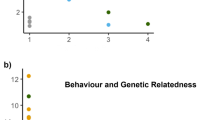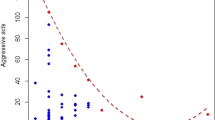Abstract
Inclusive fitness theory predicts that cost of tolerant behaviour during competitive interactions is lower for relatives than for nonrelatives. Many studies have examined the effect of relatedness on behaviour within social groups. In contrast, kin selection acting among groups has received less attention. The genetic structure of African lion (Panthera leo) populations creates a strong possibility that kin selection among groups modifies behaviour during group conflicts. We used playback experiments and genetic data to investigate the importance of relatedness during simulated territorial disputes in lions. However, we found no effect of relatedness on territorial behaviour. Degree of relatedness did not affect the decision to approach simulated intrusions, nor did it affect the behaviour during approaches. The decision to approach was instead affected by position within the territory and consecutive playback number (a measure of habituation). For playbacks that did elicit an approach, the speed of response was not detectably affected by relatedness, but was affected by odds (the ratio of residents to intruders), number of intruders, number of bouts, presence of cubs, position within the territory, temperature and playback number. Although responses were unaffected by relatedness, it remains possible that other aspects of behaviour during natural encounters among prides are affected by kin selection.

Similar content being viewed by others
References
Baglione V, Canestrari D, Marcos JM, Ekman J (2003) Kin selection in cooperative alliances of Carrion Crows. Science 300:1947–1949
Bertram BCR (1975) Social factors affecting reproduction in lions. J Zool (Lond) 177:463–482
Clutton-Brock TH, O’Riain MJ, Brotherton PNM, Gaynor D, Kansky R, Griffin AS, Manser M (1999) Selfish sentinels in cooperative mammals. Science 284:1640–1644
Creel S, Creel NM (2002) The African wild dog: behaviour, ecology and conservation. Princeton University Press, Princeton, N.J.
Creel SR, Waser PM (1994) Inclusive fitness and reproductive strategies in dwarf mongooses. Behav Ecol 5:339–348
Dugatkin LA (1997) Can kinship ever inhibit the evolution of cooperation? Ecoscience 4:460–464
Dugatkin LA, Mesterton-Gibbons M, Houston AI (1992) Beyond the Prisoner’s dilemma: toward a model to discriminate among mechanisms of cooperation in nature. Trends Evol Ecol 7:202–205
Dunn PO, Cockburn A, Mulder RA (1995) Fairy-wren helpers often care for young to which they are unrelated. Proc R Soc B 259:339–343
Emlen ST (1995) An evolutionary theory of the family. Proc Natl Acad Sci 92:8092–8099
Frame LH, Malcolm JR, Frame GW, van Lawick H (1979) Social organization of African wild dogs (Lycaon pictus) on the Serengeti plains, Tanzania 1967–1978. Z Tierpsychol 50:225–249
Goodnight KF, Queller DC (1999) Computer software for performing likelihood tests of pedigree relationship using genetic markers. Mol Ecol 8:1231–1234
Grinnell J, McComb K (1996) Maternal grouping as a defense against infanticide by males: evidence from field playback experiments on African lions. Behav Ecol 7:55–59
Grinnell J, Packer C, Pusey AE (1995) Cooperation in male lions: kinship, reciprocity or mutualism? Anim Behav 49:95–105
Hamilton WD (1963) The evolution of altruistic behaviour. Am Nat 97:354–356
Hamilton WD (1964) The genetical evolution of social behaviour, I and II. J Theor Biol 7:1–52
Heinsohn R (1997) Group territoriality in two populations of African lions. Anim Behav 53:1143–1147
Heinsohn R, Packer C (1995) Complex cooperative strategies in group-territorial African lions. Science 269:1260–1262
Hughes C (1998) Integrating molecular techniques with field methods in studies of social behaviour: a revolution results. Ecology 79:383–399
McComb K, Pusey A, Packer C, Grinnnell J (1993) Female lions can identify potentially infanticidal males from their roars. Proc R Soc B 252:59–64
McComb K, Packer C, Pusey A (1994) Roaring and numerical assessment in contests between groups of female lions, Panthera leo. Anim Behav 47:379–387
Menotti-Raymond M, David VA, Lyons LA, Schaffer AA; Tomlin JF, Hutton MK, O’ Brien SJ (1999) A genetic linkage map of microsatellites in the domestic cat (Felis catus). Genomics 57:9–23
Packer C (1986) The ecology of sociality in felids. In: Rubenstein DI, Wrangham RW (eds) Ecological aspects of social evolution. Blackwell, Oxford, pp 429–451
Packer C, Heinsohn R (1996) Reply to: lioness leadership. Science 271:1215–1216
Packer C, Pusey AE (1993) Dispersal, kinship and inbreeding in African lions. In: Thornhill NW (ed) The natural history of inbreeding and outbreeding. University of Chicago Press, Chicago, pp 375–391
Packer C, Gilbert DA, Pusey AE, O’Brien SJ (1991) A molecular genetic analysis of kinship and cooperation in African lions. Nature 351:562–565
Packer C, Pusey AE, Eberly LE (2001) Egalitarianism in female African lions. Science 293:690–693
Perrin N, Mazalov V (2000) Local competition, inbreeding, and the evolution of sex-biased dispersal. Am Nat 155:116–127
Pusey AE, Packer C (1987) The evolution of sex-biased dispersal in lions. Behaviour 101:275–310
Queller DC (1994) Genetic relatedness in viscous populations. Evol Ecol 8:70–73
Queller DC, Goodnight KF (1989) Estimating relatedness using genetic markers. Evolution 43:258–275
Scheel D, Packer C (1991) Group hunting behaviour of lions: a search for cooperation. Anim Behav 41:697–710
Spong G (2002) Space use in lions, Panthera leo, in the Selous Game Reserve. Behav Ecol Sociobiol 52:303–307
Spong G, Creel S (2001) Deriving dispersal distances from genetic data. Proc R Soc B 268:2571–2574
Spong G, Creel S, Stone J, Björklund M (2002) Genetic structure of lions (Panthera leo L.) in the Selous Game Reserve: implications for the evolution of sociality. J Evol Biol 15:945–953
Stacey PB, Koenig WD (1990) Cooperative breeding in birds. Cambridge University Press, Cambridge
Taylor PD (1992) Inclusive fitness in a homogeneous environment. Proc R Soc B 249:299–302
Vehrencamp SL (1983) A model for the evolution of despotic versus egalitarian societies. Anim Behav 31:667–682
West SA, Murray MG, Machado CA, Griffin AS, Herre EA (2001) Testing Hamilton’s rule with competition between relatives. Nature 409:510–513
Wingfield JC, Moore MC (1987) Hormonal, social and environmental factors in the reproductive biology of free-living male birds. In: Crews D (ed) Psychobiology of reproductive behaviour. Prentice-Hall, Englewood Cliffs, N.J., pp 148–175
Wingfield JC, Wada M (1989) Changes in plasma levels of testosterone during male–male interactions in the song sparrow, Melospiza meldoia: time course and specificity of response. J Comp Physiol A 166:189–194
Acknowledgements
We are grateful to the Government of Tanzania for permission to conduct research in Selous Game Reserve. For help during fieldwork we thank Sara Liljeholm and Nancy Creel. For helpful comments on previous versions of this paper, we thank Karen McComb, Craig Packer, Carl-Gustaf Thulin and Staffan Ulfstrand. This research was funded by Helge Ax:son Johnson’s foundation, the Swedish International Developmental Agency (SIDA), the Royal Swedish Academy for Sciences, the Swedish Foundation for International Cooperation in Research and Higher Education (STINT), the Lennander foundation, the National Science Foundation (IBN 9805571 and IBN 0043732) and the Frankfurt Zoological Society (project 1112/90).
Author information
Authors and Affiliations
Corresponding author
Additional information
Communicated by L. Sterck
Rights and permissions
About this article
Cite this article
Spong, G., Creel, S. Effects of kinship on territorial conflicts among groups of lions, Panthera leo . Behav Ecol Sociobiol 55, 325–331 (2004). https://doi.org/10.1007/s00265-003-0723-z
Received:
Revised:
Accepted:
Published:
Issue Date:
DOI: https://doi.org/10.1007/s00265-003-0723-z




